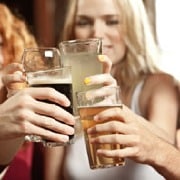Learn about drinking in college, party schools and what you can do if you don’t want to alcohol to be a part of your college life.

Partying is a major part of most people’s college experience, and with college partying comes drinking, often to the point of excess.
Depending on your tastes, this may be good or bad.
You might want to go to a notorious party school and just “let go” for four years. Or you could be looking for a school that puts academics first and operates under a dry campus policy.
Party Schools and Dry Campuses
If partying is one of your main priorities, you might want to search for a party school. This year Playboy magazine ranked the nation’s top party schools. According to their list, the top three party schools are:
- University of Colorado, Boulder
- Pennsylvania State University
- Arizona State University
While some colleges welcome the party atmosphere, others condemn it. On a dry campus, students are not allowed to consume alcoholic beverages on campus whether they are of legal drinking age or not.
Two of the best-known dry campuses are the University of Nebraska and the University of Oregon. Keep in mind though, that while their campuses might be dry, these schools are far from alcohol-free. Off-campus parties and prohibited on-campus drinking can be quite common.
Dangers of Drinking on Campus
The majority of the time, college drinking is harmless. Students are able to limit their alcohol intake and make mature choices to stay safe. But sometimes things get out of hand.
According to 2009 statistics on college drinking between the ages of 18 and 24 released by the US government:
- 599,000 students suffered unintentional injuries while under the influence of alcohol.
- 97,000 students reported sexual assault and date rape while under the influence of alcohol.
- 1,825 students died from alcohol-related unintentional injuries.
- 25 percent of college students report suffering academic consequences because of excessive drinking. These effects included missing class and doing poorly on exams and papers.
These numbers are staggering and shouldn’t be taken lightly. Responsibility is always key when making the decision to drink on campus.
Hazing and Binge Drinking
Hazing is prohibited by all colleges and universities and many school are cracking down with new rules and school legislation, but this doesn’t mean hazing is nonexistent. A common form of hazing at college fraternities and sororities and athletic teams involves binge drinking. Binge drinking is defined as drinking five consecutive alcoholic drinks in a row for males and four in a row for females.
In 1999, the hockey team at the University of Vermont was put in the spotlight after members of the team forced freshman teammates to drink warm beer until they vomited, after which they had to perform a degrading sexual act.
Hazing and binge drinking have caused multiple severe injuries and deaths at other schools across the country. It’s important to understand the consequences of such behavior and to understand the implications of peer pressure and group thinking.
Drinking in College: Tips and Tactics
What can you do to stay safe while drinking on or around a college campus?
- Eat before you drink. It slows the absorption of alcohol.
- Never drink and drive. Public and college transportation are common in college towns. Take advantage of these resources.
- Travel in groups. Muggers, pickpockets and sexual predators can prey on the intoxicated.
- Pour your own drink. Unless you are at a bar, always stick to this rule. And when you are at a bar, don’t accept drinks from strangers.
- Drink responsibly and find a good balance between your social life and academics.